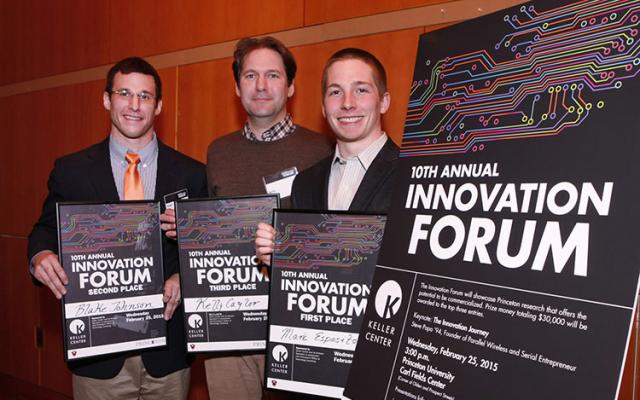
The Keller Center is pleased to announce the winners of the 2015 Innovation Forum! Visit the Princeton University homepage for full coverage of the event, and stay tuned for a complete list of participants. Below are our three winners and a brief description of their innovation.
First Place: Mark Esposito, Molecular Biology - A New Way to Discover a Cure for Cancer
Despite myriad improvements in detection, surgery, chemotherapy, radiation, and targeted biologicals, cancer death rates have only fallen 20% since their peak 25 years ago. The very simple reason why we have not yet cured cancer is that the biomedical industry and FDA have focused on treating primary tumors rather than the spread of cancerous cells to distant organs. Research in my laboratory is focused on the identification of specific biological interactions exploited by cancer cells in their spread to distant organs. My work has identified a single class of enzyme responsible for the communication between cancer cells and the organs they spread to. Following the identification of this enzyme’s importance, I have developed a rapid screening technology to identify novel drug leads and have begun the process of candidate discovery.
Second Place: Blake Johnson, Mechanical and Aerospace Engineering, 3D Printed Customized Nerve Regeneration Pathways
This innovative technology enables for the first time a personalized approach for regeneration of nerve injuries. By the direct coupling of 3D printing manufacturing principles and patient-specific 3D scanning and imaging technologies, we have achieved the ability to manufacture novel scaffolds for regenerating nerve injuries which challenge the conventional linear and unfunctionalized technology. The new 3D printed nerve regeneration technology offers the ability to personalize novel synthetic tissue scaffolds in terms of both geometry and type of nerve injury as well as to mimic the natural anatomical design of the original nerve tissue itself in terms of both physical and biochemical structure. We envision one day this reverse engineering and personalized approach to nerve regeneration will allow us to develop customized devices for use in nerve repair surgeries worldwide which offer the patient new andsignificantly improved outcomes from treatments which require surgical intervention.
Third Place: Kelly Caylor, Civil and Environmental Engineering, PulsePod
We created pulsepod to be an environmental sensing platform that is smart, simple, and deployable at scale. We work with growers and their advisors to provide decision support tools based on pulsepod's in-field monitoring of crop health, microclimate, water, and nutrients. The heart of pulsepod is a lowcost hardware hub equipped with cellular and wifi connectivity. Our pod collects environmental data using self-documenting plug-and-play sensors. An open hardware interface allows expansion and integration of existing commercial sensors. Pulsepod communicates via a secure API that serves data for web or mobile apps. We benefit our customers and society by developing affordable, application-specific recommendation systems that enhance production, conserve resources, and save money.
Congratulations to the winners and thanks to all participants for making the 10th Annual Innovation Forum a fabulous event.